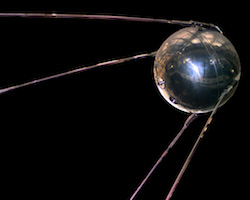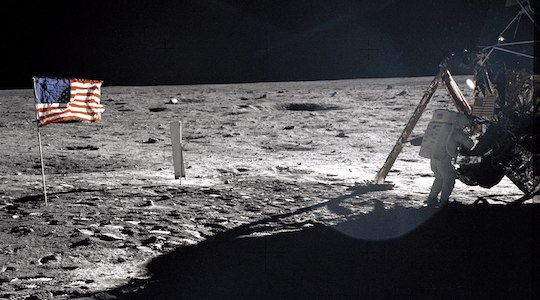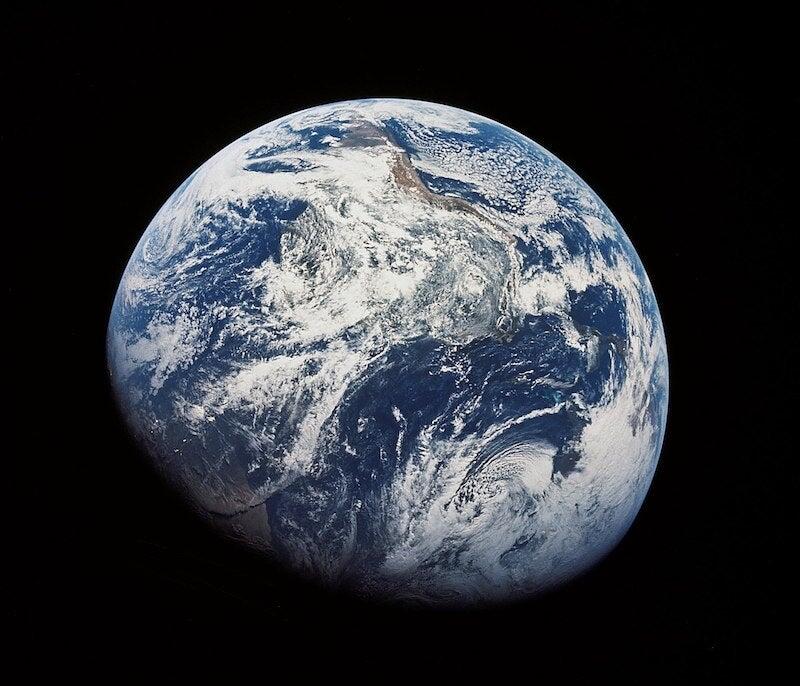
A Brief History of Spaceflight
 The history of space exploration begins in the mid-1940s. The first object launched into space was actually a rocket designed to be a weapon. This was the V2 rocket, designed by engineers in Nazi Germany. It made its historic flight in 1944.
The history of space exploration begins in the mid-1940s. The first object launched into space was actually a rocket designed to be a weapon. This was the V2 rocket, designed by engineers in Nazi Germany. It made its historic flight in 1944.
The Nazis were defeated by nations including the United States and the Soviet Union. After their victory, these two countries shifted to a cold war. The ‘cold’ part of this war means that no direct combat happened between the two countries. However, these two nations tried to show their superiority over the other for the next fifty years. For example, the two nations competed in activities like chess and sports. A more serious product of this competition was the improvement of the Nazi’s original rockets. This technology was rebuilt to allow for peaceful purposes. With these improvements, we could now launch robots and humans into space.
A Series of Firsts
The first object launched into orbit around the Earth was the Sputnik 1 satellite. Sputnik was launched on October 4th, 1957 by the Soviet Union. It was essentially a radio beacon, designed to send a beeping signal that could be picked up around the world. (You can listen to the simple Sputnik radio signal here).
 The success of Sputnik showed the superiority of the Soviet Union at the time. Not to be outdone, the United States launched its first satellite, Explorer 1, just a few months later. This launch took place on January 31st, 1958. Explorer 1 was packed with scientific instruments. It returned a lot of data about space just above our planet’s atmosphere. This environment and beyond, at 100 kilometers (or about 62 miles) above the Earth’s surface, is now thought of as the boundary of space.
The success of Sputnik showed the superiority of the Soviet Union at the time. Not to be outdone, the United States launched its first satellite, Explorer 1, just a few months later. This launch took place on January 31st, 1958. Explorer 1 was packed with scientific instruments. It returned a lot of data about space just above our planet’s atmosphere. This environment and beyond, at 100 kilometers (or about 62 miles) above the Earth’s surface, is now thought of as the boundary of space.
The Soviet Union continued to beat the United States in space exploration for the next 10 years. They successfully launched the first human into space, Yuri Gagarin.
Yuri’s flight took place on April 12th, 1961. Just before the launch of the rocket, the launch control room operator, Sergei Korolev, updated Yuri on the status of the rocket. “Preliminary engine lit… intermediate engine lit… main engine ignition… lift off!” The rocket roared to life and began to lift Yuri upwards into the sky. “We wish you a good flight! Everything is all right!” said Korolev. Yuri responded with words that capture the excitement of space exploration: “Поехали!” Pronounced po-yek-hali, this phrase is Russian for “Let’s go!” Yuri’s flight lasted about two hours before he returned to Earth.
 The Soviet Union also launched the first woman into space. Her name is Valentina Tereshkova. Valentina’s flight was on June 16th, 1963. Her spaceflight lasted 3 whole days. During her flight, she orbited Earth 48 times. Imagine seeing the sun rise and set 48 times in a span of just a few days! Before her flight, American astronauts had spent less than 3 days total in space. So her flight alone beat all of the American spaceflight experience!
The Soviet Union also launched the first woman into space. Her name is Valentina Tereshkova. Valentina’s flight was on June 16th, 1963. Her spaceflight lasted 3 whole days. During her flight, she orbited Earth 48 times. Imagine seeing the sun rise and set 48 times in a span of just a few days! Before her flight, American astronauts had spent less than 3 days total in space. So her flight alone beat all of the American spaceflight experience!
The Legacy of Apollo
To catch up and move ahead of their Soviet rivals, the United States started the Apollo Program, which focused on landing astronauts on the Moon. In a speech to Congress in May 1961, President Kennedy stated that “no single space project in this period will be more impressive to mankind.”
Thanks to the efforts of thousands of scientists and engineers, the US reached this goal in July of 1969. A group of three astronauts launched in a capsule on top of the massive Saturn V (pronounced Saturn five) rocket. The launch happened on the morning of July 16th, 1969 in perfect weather. It is estimated that over a million people watched this launch in person. Imagine seeing this massive rocket soar through the crisp, blue Florida sky. Its five giant rocket engines would have sounded like they were ripping apart the sky. This rocket was carrying the first humans to travel to another celestial body.
 Just a few days later, two of the crew members launched that day would land on the Moon. These two astronauts were Neil Armstrong and Edwin ‘Buzz’ Aldrin. This was the first time humans had ever walked on another object in space, and so Neil and Buzz wanted to be very careful about leaving the spacecraft. It took them three hours to put on their space suits. Finally, Neil and Buzz were ready to exit the spacecraft and take the first steps on the Moon. Neil exited the spacecraft first, slowly climbing down a ladder to the surface.
Just a few days later, two of the crew members launched that day would land on the Moon. These two astronauts were Neil Armstrong and Edwin ‘Buzz’ Aldrin. This was the first time humans had ever walked on another object in space, and so Neil and Buzz wanted to be very careful about leaving the spacecraft. It took them three hours to put on their space suits. Finally, Neil and Buzz were ready to exit the spacecraft and take the first steps on the Moon. Neil exited the spacecraft first, slowly climbing down a ladder to the surface.
With his heart racing, Neil was having trouble seeing where to step due to the bulky spacesuit. He activated a TV camera which began broadcasting his descent to 600 million people back on Earth. After reporting his observations of the lunar soil as ‘almost like a powder’, Neil took the first step onto the Moon. His statement has become part of the history of our species: “That’s one small step for man, one giant leap for mankind.”

There were six Apollo missions that landed on the Moon. In total, 12 humans have walked on the Moon’s surface. They collected lunar rocks and took hundreds of pictures. They set up many instruments to measure the properties of the Moon. Fifty years later, we are still studying the data they collected.
Space Exploration After Apollo
After Apollo, we began using robots to explore the planets. Meanwhile, human exploration focused on construction in Earth orbit. Many space stations were built to study long-duration human activity in space. Space stations are unique spacecraft intended to support human activity in one location in space.
During this time, cosmonaut Valeri Polyakov set the record for longest human spaceflight. This record is 437 days or about 14 months. The space station that he lived on, Mir, was his home during this time. Mir’s living space was about the same as a normal-sized American house. Can you imagine living inside your house and being unable to go outside, for over a year? You would have perhaps the best view of any humans, though.
 Today, the International Space Station (ISS) is the largest human-made structure in space. It represents one of the greatest collaborations in human history. The ISS was finished in 2011 after 18 countries had contributed to the effort. It weighs nearly one million pounds (or ~450,000 kg) and is larger than a football field. For comparison, that’s about 350 average-sized cars! Research performed on the ISS has improved our understanding of health and safety in space. It has also given us a new platform to observe the Earth.
Today, the International Space Station (ISS) is the largest human-made structure in space. It represents one of the greatest collaborations in human history. The ISS was finished in 2011 after 18 countries had contributed to the effort. It weighs nearly one million pounds (or ~450,000 kg) and is larger than a football field. For comparison, that’s about 350 average-sized cars! Research performed on the ISS has improved our understanding of health and safety in space. It has also given us a new platform to observe the Earth.
Additional images via Wikimedia Commons. Image of the Earth by the US Government.

One of the first images taken by a human of the entire Earth at a distance, taken by someone on the crew of the Apollo 8.
Be Part of
Ask An Earth and
Space Scientist
By volunteering, or simply sending us feedback on the site. Scientists, teachers, writers, illustrators, and translators are all important to the program. If you are interested in helping with the website we have a volunteers page to get the process started.
